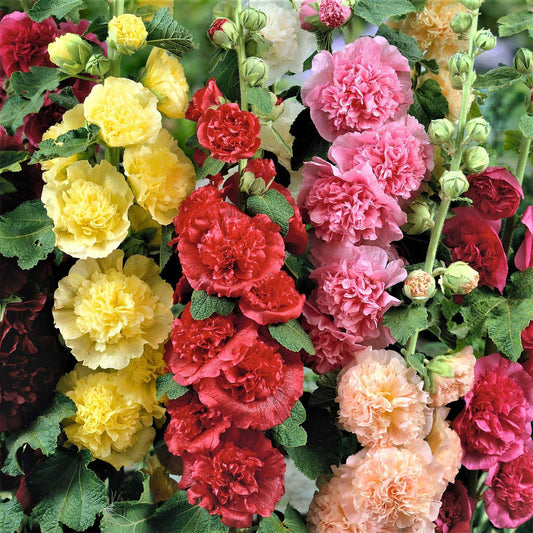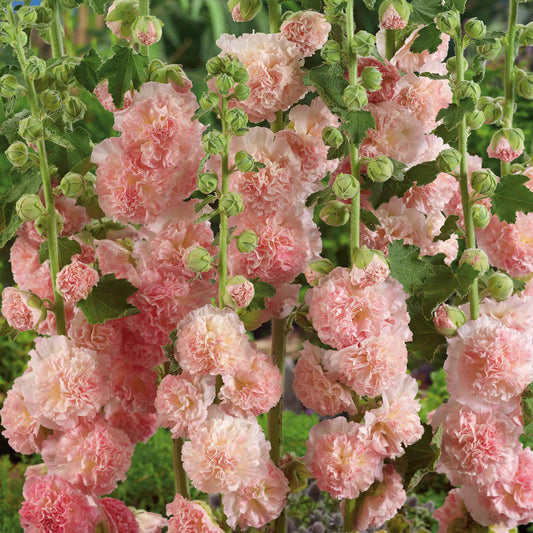-
main-collection-product-grid

Hollyhock Roots - Chamois
Peaceful antique-peach, cottage-style blossoms shift subtly in tone as flowers matureHollyhock Roots - Chamois
Peaceful antique-peach, cottage-style blossoms shift subtly in tone as flowers matureRegular price As Low As $12.99Regular priceUnit price per -
main-collection-product-grid

Hollyhock Roots - Chaters Mix
Member of the Chater's Double Hollyhock cultivar, with tall, upright stems covered in fully double, pom-pom type bloomsHollyhock Roots - Chaters Mix
Member of the Chater's Double Hollyhock cultivar, with tall, upright stems covered in fully double, pom-pom type bloomsRegular price As Low As $18.99Regular priceUnit price per -
main-collection-product-grid

Hollyhock Roots - Peaches 'n Dreams
Fully double, peony-like flowers create a lush, layered lookHollyhock Roots - Peaches 'n Dreams
Fully double, peony-like flowers create a lush, layered lookRegular price As Low As $12.99Regular priceUnit price per
Why Gardeners Love Hollyhocks
- Timeless favorites giving that classic, cottage appeal since Victorian times
- Pollinator magnets attracting bees, butterflies, and humming birds
- Easy to grow in full sun with well-drained soil
- Continuous flowers from midsummer through early fall
A Timeless Flower with Deep Roots in Garden History
Hollyhocks have been cherished for centuries, originating in Asia and brought to Europe by early plant explorers. Their name, “holy hoc,” is said to come from medieval pilgrims who carried the plant’s roots for their soothing medicinal uses. They became a mainstay of English cottage gardens and then colonial homesteads in our country. Noted American architect Frank Lloyd Wright was commissioned to construct the Hollyhock House, a home named after the owner’s favorite flower, whose stylized motifs can be seen throughout the home’s design.
Today, these plants remain symbols of warmth, nostalgia, and garden abundance as they have been naturalized around the world. Chater’s Mix offers a rainbow of fully double blooms in reds, pinks, yellows, and whites; Peaches ‘n Dreams adds a romantic, soft pastel touch; and Chamois brings gentle coral and apricot tones that seem to glow in the evening light.
Will Hollyhock Roots Bloom the First Year?
Planting from roots (rather than seed) gives you a head start as strong, established plants that bloom sooner and stand tall in their first season. Its roots have already had time to develop crowns and now they have the stored energy to push up strong stems and flowers. With full sun, regular watering, and rich soil, you can expect tall, colorful flower spikes by midsummer of the first growing season. Use them to frame garden gates, line fences, or rise gracefully behind delphiniums, foxgloves, or daisies for a picture-perfect summer display.
An Easy to Grow Garden Addition
Few flowers capture the charm and romance of a cottage garden like hollyhocks, alcea rosea. Tall, stately spires and generous clusters of blooms make hollyhock an instant favorite by providing not only height and color, but nostalgia as well. These classic perennials are surprisingly versatile, offering a range of creative uses as a backdrop in borders or as planted in a group as ceremonial guardians of the garden.
Let’s face it, it’s the storybook cottage look that we are after when planting hollyhocks, and we envision them along a garden fence or wall to frame the landscape. But for a more natural, meadow-inspired feel, try planting them among ornamental grasses or behind lower perennials, where their height adds depth and structure. In smaller gardens, group them in corners or near entrances to create a welcoming focal point that draws your gaze upward.
No matter where they are planted, hollyhocks bring their old-fashioned beauty and charm to the summer and fall gardens. Happiest in sunny spots with good air circulation, bring hollyhocks to your garden and enjoy a timeless flower that has inspired gardeners, architects, and artists worldwide.


